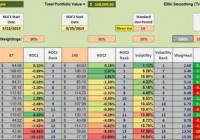Dual Momentum Model Recommends Move To Bonds Or Cash
The Dual Momentum model recommended selling equities as far back as August 10th. A slight modification of the Dual Momentum model recommends holding Cash or SHY. Look-back periods make a difference in recommendations. Three metrics, as described in the second table, improve returns and reduce annual draw-downs. Momentum investors following the Dual Momentum model are currently invested in either bonds or cash depending on how strict they follow the DM guidelines. In the following table the look-back period is one year or 365 days as recommended in Gary Antonacci’s book, Dual Momentum Investing . Exchange Traded Funds representing U.S. and International Equities markets are substituted for those securities suggested in Antonacci’s book. These ETFs are commission free securities available through several discount brokerage houses. VTI covers U.S. Equities while VEU represents International Equities. If neither VTI or VEU outperforms SHY , our cutoff ETF, we move to bonds. In this momentum model an intermediate bond BIV is selected as an obvious choice. One could also use BND as the bond representative. Using the 365-Day look-back period, the current recommendation is to invest 100% in bonds. Investors may wish to wait until after the FEDs settle on an interest rate rise before making this move. (click to enlarge) An alternative model to the above DM is shown in the following screen shot. After hours of research using a Monte Carlo model, a different look-back emerges. In the following model a 30% weight is assigned to the performance over the most recent 87 calendar days while a 50% weight is assigned to the most recent 145 calendar days. To hold down portfolio volatility and reduce risk, a 20% weight is assigned to a 14 calendar day mean-variance. Following these three metrics improves performance while reducing draw-down with respect to either the S&P 500 or VTSMX benchmarks. This can also be demonstrated using out-of-sample data. Numerous portfolios are now undergoing additional testing of this three-metric model. Using these three metrics, the recommendation varies slightly from the above DM model as investors are now advised to invest 100% in SHY, the “circuit breaker” ETF. Moving to SHY or Cash was recommended as far back as August 10th . One adjustment is advised when both VTI and VEA are out of favor as is now the situation. Instead of maintaining the 30% – 50% weights assigned to the 87- and 145-day periods, reverse those percentages. The reason is to place more weight on the most recent period so as to catch the upward swing when the market begins to rebound. As for the current situation, the Dual Momentum model recommends holding 100% in bonds while the revised DM model recommends holding 100% in Cash or SHY. Both are conservative portfolio positions. (click to enlarge) Disclosure: I am/we are long SHY. (More…) I wrote this article myself, and it expresses my own opinions. I am not receiving compensation for it (other than from Seeking Alpha). I have no business relationship with any company whose stock is mentioned in this article. Share this article with a colleague
